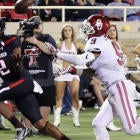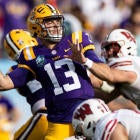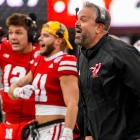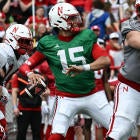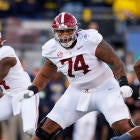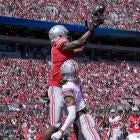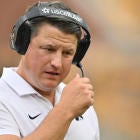Was Oklahoma-Texas Tech good for college football?
The Sooners' 66-59 win Saturday may have elicited more emotion than any game this season. It wasn't just a score; it was a scoring orgy. Defense wasn't optional; it was nonexistent.
Traditionalists gasped. To paraphrase a certain Alabama head coach: Is this what we want the game to be?
Either way, you had to have an opinion.
"I thought it was riveting," said Brian Hanni, the voice of the Kansas Jayhawks who used to do pre- and postgame broadcasts for the Red Raiders. "It was after 11 o'clock on a Saturday night. I could be out doing other things. I'm sure those guys from another generation are rolling over in their graves seeing 88 pass attempts."
Instead of getting all high and mighty about it ourselves, we reached out to trained football professionals for their opinions. What did they think of a game that featured 18 scores in 25 total possessions (not counting kneel downs)? There were all of four punts. That game alone raised the Big 12 scoring average 4 percent (to more than 37 points per game).
Texas Tech's Patrick Mahomes was the author of those 88 passes that produced an FBS-record tying 734 yards.
"Offense sells tickets and defense wins championships," Bob Bowlsby said. "When you come right down to it, you have to be able to defend. Every team is going to be put in a situation where they have to defend. If you can't do it, it's hard to win the big game."
That, mind you, is the Big 12's commissioner.
Washington State coach Mike Leach has to be a go-to source in this discussion. He started his major-college coaching career under Bob Stoops. As a head coach, Leach led Texas Tech to its greatest run of glory from 2000-09.
For gosh sakes, the teams were both running versions of the spread offense he helped create.
"I didn't see it but out of personal curiosity I have texted some guys to ask basically, that's the question, 'What happened?'" Leach said.
What happened is that two elite quarterbacks (Mahomes and Oklahoma's Baker Mayfield) took advantage of two defenses that have been lacking. Mayfield threw a Big 12-record seven touchdowns against the nation's second-worst defense.
Even that result was surprising in a sport that has been experiencing an offensive revolution for the past 15 years.
The current scoring average of 30.4 points per team would shatter the national season record for the sixth time since 2000.
One theory: There are no secrets. Leach, along with Hal Mumme, practically invented the modern spread offense.
"In one phone call I can get 12 films on anybody and I mean anybody," Leach said. "No matter how secretive somebody is, if I can't get it in one phone call, I can definitely get in two.
"The problem right now is I'm playing against myself a lot now. We see some of the stuff against us that we've been doing for 20 years."
And defenses, in general, aren't even close to catching up. Don't forget, we're coming off the highest-scoring championship game in history (Alabama 45, Clemson 40). That game featured three of the best defensive minds in the game -- Brent Venables, Kirby Smart and Nick Saban.
"At the end of the day, will this style of play win a national championship?" asked CBS Sports college football analyst Brady Quinn. "I don't know that we have seen that but it's trending in that direction."
The definition of quality defense has undergone a radical transformation. Since 2002, there have been only two teams that have allowed less than 10 points per game (2008 Southern California, 2011 Alabama).
From 1997-2001, there were three. One of those, Michigan in 1997, won the national championship.
"If that's the case then the offensive play we saw from OU and Texas Tech the other night is simply the evolution of offense in college football," Quinn added. "It's up to the defense to answer the challenge of finding a way to adapt."
They might, some day. But so far scoring remains on an upward trajectory. It was decided years ago the game had become too staid and boring. Rules were changed to open up offenses.
But is there that opposite reaction that the game has become too wide open?
"That ebbs and flows," said Bowlsby, who is also the head of the NCAA's Football Oversight Committee. Any rules changes would have to be filtered through his group.
"Sometimes you begin tending back toward things that favor the defense. Then you tend toward things that tend toward offense."
There is no doubt pace of play has increased. More plays equals more scoring opportunities. To date this season, teams have run an average of 72 plays per game. That would be a new record and represent a 12.7 percent increase in the last 11 years.
You might have noticed Cal ran 118 plays Friday in its overtime win over Oregon.
In many ways, Leach made Saturday's scorefest possible. It was his version of the spread that infected the Big 12 beginning in 1999 at Oklahoma where he was offensive coordinator.
It flourished at Texas Tech. Opposing coaches found it easier to imitate Leach's offense than try to stop it. The conference produced offensive greats like Dez Bryant, Michael Crabtree, Vince Young, Sam Bradford and current Red Raiders coach Kliff Kingsbury.
But the league has won just one national championship since 2000 (Texas in 2005). What remains is an offensive culture/reputation the Big 12 sometimes has to live down.
"College football is the most exciting brand of football, no question about it," Leach said. "It's not like the NFL where everybody looks the same. You still do have those baseball-score games. And you have the Oklahoma-Tech stuff. The contrast of it, it's captivating."
Leach reiterated that modern spread offenses trace their roots back to the option football of the wishbone. Urban Meyer's offense is an offshoot of that, reflecting those of the old single-wing and wing-T offenses.
Same for the spreads of Chip Kelly and Gus Malzahn. Those two coaches spread out defenses to run. Leach continues to spread out defenses to throw. His quarterback, Luke Falk, is in the top five in passing for the second consecutive year.
"Defenses are going to adapt to a point where there is going to be less of [the scoring]," Leach said. "I wish nobody else ran our stuff."
While college football attendance and TV ratings are flat at the moment, no one is blaming too many points. The likes of Stoops are blaming themselves after Saturday night.
"That wasn't a bit entertaining," said OU's team leader, a defensive coach at heart. "Are you kidding me?"
Beauty, then, is in the eye of the remote holder.
"If you're a fan of defense, it probably wasn't what you were looking for in late-night entertainment," Bowlsby said. "If you're a fan of offense, there was a lot of innovative offense there."
Mixon now more than ever: It's curious that Oklahoma's Joe Mixon is barely being mentioned this week for, well, any awards. OU's redshirt sophomore tailback had the game of his life against Texas Tech -- 263 rushing yards, five touchdowns. Perhaps Mixon is being overshadowed by Mayfield, his teammate.
That doesn't explain the fact that right now he is the Christian McCaffrey of 2016. That is, Mixon is second in all-purpose yards, first among Power Five players (207 per game). He is also the No. 2 rusher in the Big 12, averaging 105 yards per game.
There is no doubt Mixon is emerging as perhaps the Big 12's player of the year. But to many, he's known most for punching OU student Amelia Molitor 2 ½ years ago. Her compelling story can be read here.
No matter what Mixon does from here on, it's simply hard to separate greatness on the field from personal conduct. That's not to say Mixon doesn't deserve a chance. It does begin to explain why the possible Big 12 player of the year is barely showing up on Heisman Trophy lists.
Penn State's resurgence: Has there been a quicker turnaround for the fortunes of a program and its coach? Penn State's win over Ohio State not only rehabbed the prospects of coach James Franklin, it created a path for the Nittany Lions to play for the Big Ten title.
Who would have even thought about such a thing last week? But here goes ...
Penn State (5-2) is now tied for second in the East Division with Ohio State (3-1 Big Ten). The Nittany Lions' final five games are winnable -- Purdue, Iowa, Indiana, Rutgers, Michigan State. If Penn State wins out and Ohio State beats Michigan, that would create a three-way tie in the East. Those three teams would all be 8-1.
At that point, it looks like it would come down to the fifth tiebreaker, according to the Big Ten website. That is, best overall winning percentage. CBS Sports bowls expert Jerry Palm notes that Ohio State would win the three-way tie scenario.
Penn State would have to win out and Michigan would have to lose twice. (Yeah, I know, slim chance.) Then it becomes a head-to-head between Penn State and Ohio State.
Only if you missed the joyous riot in Happy Valley Saturday night do you not know the result of that tiebreaker.
Short gains: Looking ahead a month, that Michigan-Ohio State game will mark Jim Harbaugh's first visit to Ohio Stadium in 30 years. Three decades ago, as Michigan's quarterback, he guaranteed a win. The Wolverines prevailed 26-24 ... By the way, Urban Meyer was a grad assistant for Earle Bruce on the other sideline that day ... More Leach apropos of nothing: "Here's caveman football for you -- the Wildcat. I think it's a horrible offense. That's crazy. Fred Flintstone, he played in the Wildcat." ... The finalists for the Big 12 championship game beginning next year are Dallas, San Antonio and Kansas City. The league intends to award five games to one or any combination of those cities from 2017-21 ... We should know more on how those teams playing for the championship will be decided sometime soon after Nov. 1. Bowlsby said no final decision has been made on definitely splitting up into divisions.












